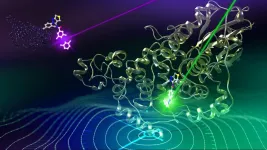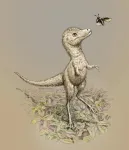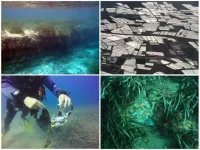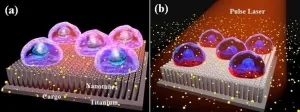A world first in circadian clock manipulation
New method allows reversible manipulation of the circadian period using light
2021-01-25
(Press-News.org) The Nagoya University Institute of Transformative Bio-Molecules (WPI-ITbM) research team of Designated Associate Professor Tsuyoshi Hirota, Postdoctoral Fellow Simon Miller, Professor Kenichiro Itami and graduate student Tsuyoshi Oshima (Research Fellowship for Young Scientists, JSPS), in collaboration with the group of Professor Ben Feringa and Postdoctoral Fellow Dušan Kolarski of Groningen University in the Netherlands, have achieved a world first: fully reversible manipulation of the period of the circadian clock using light, by exchanging part of a compound with a light-activated switch.
Waking in the morning, sleeping at night - the majority of our biological activities repeat within a daily cycle. The internal process which governs this rhythm is known as the circadian clock. While it is understood that the circadian clock is controlled by the combined functions of clock genes and clock proteins, the process by which it is possible to control and stabilize the rhythm over the lengthy period of a day has been shrouded in mystery. In order to tackle this question, the researchers established a chemical biology process for large-scale analysis of the effect of compounds on the circadian rhythm in cultured human cells, elucidating the significant molecular mechanisms which determine the daily period.
This large-scale chemical screening identified two compounds - TH303 and its analogue TH129 - which lengthened the circadian clock period. The research team then worked on elucidating how these compounds interact with the clock protein CRY1 at a molecular level using X-ray crystallography. They found that part of these compounds, known as a benzophenone, possessed a similar structure to the cis isomer of azobenzene, a light-activated switch. When they then analyzed the response to light of GO1323, a variant of TH129 in which benzophenone is displaced by azobenzene, they found that its structure changed to the cis isomer under ultraviolet light, and back to the trans isomer under white light. According to computer simulations, the cis isomer of GO1323 interacts identically to TH129 with CRY1, while the trans isomer has no interaction with it.
Thus, when exposed to ultraviolet light, the circadian clock period of cultured human cells which had been treated with GO1323 was extended compared with those which had been kept in the dark. Furthermore, when exposed to white light, these cells' circadian clock period returned to normal, proving that the process is reversible. As ultraviolet light is damaging to cells, the research team had to find a way to adapt the process to use a non-harmful area of the spectrum to extend the period. They synthesized GO1423, containing tetraorthofluoroazobenzine. This compound changes to its cis isomer under green light, and to its trans isomer under violet light, while maintaining the other desirable characteristics of GO1323. When cells treated with GO1423 were exposed to green light, their circadian rhythm period was extended compared with those which had been kept in the dark, and when exposed to violet light, the effect was reversed. Thus, the researchers succeeded in producing a reversible method for controlling the circadian clock period using visible light.
Control of the circadian clock using methods such as these is expected to contribute to the treatment of related diseases such as sleep disorders, metabolic syndrome and cancer, and this research achievement represents an important and exciting step forward in the field.
INFORMATION:
[Attachments] See images for this press release:

ELSE PRESS RELEASES FROM THIS DATE:
2021-01-25
Greater sports participation among Aboriginal and Torres Strait Islander children is linked with better academic performance, according to new research from the University of South Australia.
Conducted in partnership with the University of Sydney and the University of Technology Sydney, the world-first study found that Aboriginal and Torres Strait Islander children who played organised sports every year over four years, had numeracy skills which were advanced by seven months, compared to children who did less sport.
The study used data from four successive waves of Australia's Longitudinal Study of Indigenous Children, following 303 students (with a baseline age of five to six years old) to assess cumulative sports participation against ...
2021-01-25
A world-first discovery by researchers at Monash University and The University of Queensland could lead to faster and more effective treatments for chronic health complications, such as cardiovascular disease and cancer, with 'fluorescent' in vivo biosensors.
The research team, led by Dr Simon Corrie from Monash University's Department of Chemical Engineering and the ARC Centre of Excellence in Convergent Bio-Nano Science and Technology, took an antibody that binds EGFR (epidermal growth factor receptor) proteins and engineered it to monitor the concentration of EGFR proteins in serum solutions over time.
Co-authors of the paper, published in ACS Sensors, are Dr Christian Fercher, Dr Martina ...
2021-01-25
They are among the largest predators ever to walk the Earth, but experts have discovered that some baby tyrannosaurs were only the size of a Border Collie dog when they took their first steps.
The first-known fossils of tyrannosaur embryos have shed light on the early development of the colossal animals, which could grow to 40 feet in length and weigh eight tonnes.
A team of palaeontologists, led by a University of Edinburgh researcher, made the discovery by examining the fossilised remains of a tiny jaw bone and claw unearthed in Canada and the US.
Producing 3D scans of the delicate fragments revealed that they belonged to baby tyrannosaurs ...
2021-01-25
Scientists from UNSW Sydney have developed a ceramic-based ink that may allow surgeons in the future to 3D-print bone parts complete with living cells that could be used to repair damaged bone tissue.
Using a 3D-printer that deploys a special ink made up of calcium phosphate, the scientists developed a new technique, known as ceramic omnidirectional bioprinting in cell-suspensions (COBICS), enabling them to print bone-like structures that harden in a matter of minutes when placed in water.
While the idea of 3D-printing bone-mimicking structures is not new, this is the first time such material can be created at room temperature - complete with living cells ...
2021-01-25
The carbon footprint of plastic production for initial use is greater than the global warming impact of the entire process used for medical device reprocessing Use of reprocessed devices is environmentally superior to use of original products in 13 of 16 categories evaluatedReprocessing found to advance "circular economy," a key strategy for reaching the UN Sustainability GoalsLCA offers evidence showing that in order to reduce greenhouse gas emissions and honor the Paris Climate Agreement, EU Member States must opt-in to EU Medical Device Regulation (MDR)'s reprocessing/remanufacturing provisions
[Berlin / Washington, ...
2021-01-25
Large-scale production of vegetables and fruit in Spain with intensive plastic consumption in its greenhouse industry is believed to have leaked microplastic contaminants since the 1970s into the surrounding Mediterranean seagrass beds. This is shown in a new study where researchers have succeeded in tracing plastic pollution since the 1930s and 1940s by analyzing seagrass sediments.
About half of Sweden's cucumbers and a fifth of the tomatoes in Sweden are currently imported from Spain according to the Swedish Board of Agriculture. A special area in Spain where large-scale vegetable cultivation ...
2021-01-25
Overview:
A research team at the Department of Mechanical Engineering at Toyohashi University of Technology developed a nanosecond pulse laser-assisted photoporation method using titanium-oxide nanotubes (TNTs) for highly efficient and low-cost intracellular delivery. The proof of concept for the possibility of intracellular delivery after irradiation with nanosecond pulse laser on TNTs was validated. TNTs were formed on titanium sheets using the electrochemical anodization technique at different voltages and times. HeLa - human cervical cancer cells were cultured in the nanotubes and submerged in a solution of biomolecules. After cells were exposed to nanosecond pulse laser, we successfully delivered ...
2021-01-25
There isn't much in Kamchatka, a remote peninsula in northeastern Russia just across the Bering Sea from Alaska, besides an impressive population of brown bears and the most explosive volcano in the world.
Kamchatka's Shiveluch volcano has had more than 40 violent eruptions over the last 10,000 years. The last gigantic blast occurred in 1964, creating a new crater and covering an area of nearly 100 square kilometers with pyroclastic flows. But Shiveluch is actually currently erupting, as it has been for over 20 years. So why would anyone risk venturing too close?
Researchers from Washington University in St. Louis, including Michael Krawczynski, assistant professor of earth and planetary sciences in Arts & Sciences and graduate student ...
2021-01-25
Abusive bosses may retain their positions by taking superficial steps to repair their social images following outbursts, without acting meaningfully to change their behaviors, according to research led by a University of Wyoming business management expert.
Shawn McClean, an assistant professor in UW's College of Business, joined colleagues from the University of Iowa, the University of Nebraska-Lincoln and Texas A&M University in conducting the research, which appears in the journal Personnel Psychology. Their study also was featured in Harvard Business Review, a preeminent business magazine.
"Our study shows that supervisors are often driven by simply repairing their social image rather than ...
2021-01-25
Male breast cancer patients were found to have a high prevalence of cardiovascular conditions, in a small study of this rare patient population presented at the American College of Cardiology's Advancing the Cardiovascular Care of the Oncology Patient Virtual course.
"Due to the rarity of male breast cancer, there is no cardiovascular data from larger clinical trials or population studies. The lack of large data makes it even more important to individualize cardiovascular assessment and management based on each patient's unique oncologic, therapeutic and pre-existing cardiovascular risk profile to support them through cancer treatment into survivorship," said Michael Ibrahim, fourth year ...
LAST 30 PRESS RELEASES:
[Press-News.org] A world first in circadian clock manipulation
New method allows reversible manipulation of the circadian period using light





